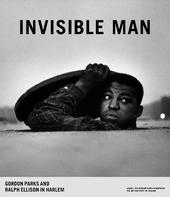
|
Invisible Man: Gordon Parks and Ralph Ellison in Harlem
Hardback
Main Details
| Title |
Invisible Man: Gordon Parks and Ralph Ellison in Harlem
|
| Authors and Contributors |
By (author) Michal Raz-Russo
|
| Physical Properties |
| Format:Hardback | | Pages:168 | | Dimensions(mm): Height 290,Width 250 |
|
| Category/Genre | Individual photographers
Individual film directors and film-makers
Bands, groups and musicians |
|---|
| ISBN/Barcode |
9783958291096
|
| Classifications | Dewey:779 |
|---|
| Audience | |
|---|
| Illustrations |
Illustrated in colour and tritone throughout
|
|
Publishing Details |
| Publisher |
Steidl Publishers
|
| Imprint |
Steidl Verlag
|
| Publication Date |
18 April 2016 |
| Publication Country |
Germany
|
Description
By the mid-1940s, Gordon Parks was a successful photographer and Ralph Ellison began work on his acclaimed novel Invisible Man (1952). It is relatively unknown, however, that the two men were friends and that their common vision of racial injustice inspired collaboration on two important projects, in 1948 and 1952. Parks and Ellison first joined forces on an essay titled "Harlem Is Nowhere" for '48: The Magazine of the Year. Conceived while Ellison was already writing Invisible Man, this illustrated essay was centered on Harlem's Lafargue Mental Hygiene Clinic-the first non-segregated psychiatric clinic in New York City-as a case study for the social and economic conditions of the neighborhood. He chose Parks to create the accompanying photographs and during the winter months of 1948, the two roamed the streets of Harlem. In 1952 they worked together again on "A Man Becomes Invisible" for the August 25 issue of Life magazine, which promoted Ellison's newly released novel. This is the first publication on Parks' and Ellison's collaboration on these two projects, one of which was lost while the other was published only in reduced form. The catalogue provides an in-depth look at the artists' shared vision of black life in America, with Harlem as its nerve center.
Author Biography
Gordon Parks was born into poverty and segregation in Fort Scott, Kansas, in 1912. An itinerant labourer, he worked as a brothel pianist and railcar porter, among other jobs, before buying a camera at a pawnshop, training himself, and becoming a photographer. He served as a photographer for the Farm Security Administration and the Office of War Information (1941-1945) and Life magazine (1948-1972) and found success as a film director, author and composer. The first African-American director to helm a major motion picture, he popularised the Blaxploitation genre through his film Shaft (1971). He wrote numerous memoirs, novels and books of poetry, and received many awards, including the National Medal of Arts, and more than fifty honorary degrees. Parks died in 2006. Ralph Ellison was born in Oklahoma City in 1913. He enrolled at Booker T. Washington's Tuskegee Institute in Macon County, Alabama, as a music major and later turned to writing essays and short stories. By 1945 he signed a contract to begin writing what was to become Invisible Man (1952), which won the National Book Award in 1953 but remained the only novel published during his lifetime. Ellison published two subsequent collections of essays: Shadow and Act (1964) and Going to the Territory (1986). Ellison died in 1994.
Reviews...captures the rich expressiveness of their work in an austerely designed format that honors both the imagery and the prose and invites the reader to linger over the page.--Michal Raz-Russo "On the Seawall" brings together the important collaboration between two artistic geniuses...the relevance of social change has never rung so true.--Liz Ronk "Time, Best Photobooks of 2016" Gordon Parks and Ralph Ellison, two of the 20th century's most celebrated artists, shared a vision of what it meant to be black in the US. Parks, a photographer and filmmaker, and Ellison, a novelist and essayist, collaborated twice on projects that revealed, through words and images, what they believed to be essential aspects of the African American condition. Although the collaborations differed in form, the sensibility that animated them was the same, and so was the setting -- Harlem.--John Edwin Mason "Hyperallergic" Illuminating both the parallels and divergences between Parks's and Ellison's work, this show promises a new perspective on the pair's joint use of photography during the civil rights movement, a period of heightened attention to the rhetoric of images.--Solveig Nelson "Artforum"
|